《DSP using MATLAB》Problem 7.34

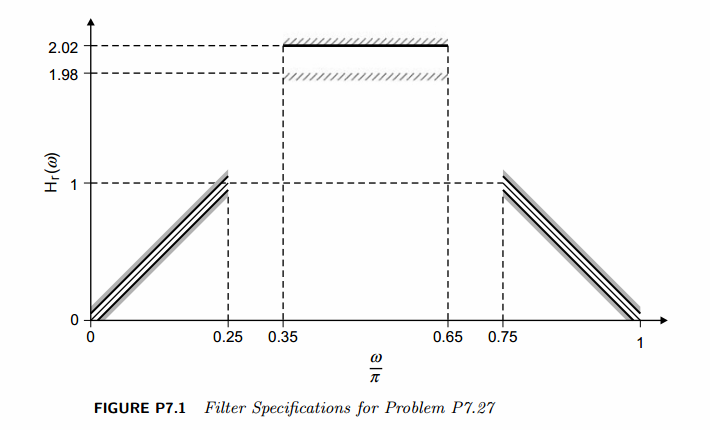
代码:
%% ++++++++++++++++++++++++++++++++++++++++++++++++++++++++++++++++++++++++++++++++
%% Output Info about this m-file
fprintf('\n***********************************************************\n');
fprintf(' <DSP using MATLAB> Problem 7.34 \n\n'); banner();
%% ++++++++++++++++++++++++++++++++++++++++++++++++++++++++++++++++++++++++++++++++ % bandpass in Fig P7.1
ws1 = 0.25*pi; wp1 = 0.35*pi; wp2 = 0.65*pi; ws2=0.75*pi;
delta1 = 0.05; delta2 = 0.02; delta3 = 0.05;
weights = [1 delta3/delta2 1]; Dw = min((wp1-ws1), (ws2-wp2));
M = ceil((-20*log10((delta1*delta2*delta3)^(1/3)) - 13) / (2.285*Dw) + 1) deltaH = max([delta1,delta2,delta3]); deltaL = min([delta1,delta2,delta3]); f = [ 0 ws1 wp1 wp2 ws2 pi]/pi;
m = [ 0 1 2 2 1 0]; h = firpm(M-1, f, m, weights);
[db, mag, pha, grd, w] = freqz_m(h, [1]);
delta_w = 2*pi/1000;
ws1i = floor(ws1/delta_w)+1; wp1i = floor(wp1/delta_w)+1;
wp2i = floor(wp2/delta_w)+1; ws2i = floor(ws2/delta_w)+1; Asd = -max(db(1:ws1i)) %[Hr, ww, a, L] = Hr_Type1(h);
[Hr,omega,P,L] = ampl_res(h);
l = 0:M-1; %% -------------------------------------------------
%% Plot
%% ------------------------------------------------- figure('NumberTitle', 'off', 'Name', 'Problem 7.34 Parks-McClellan Method')
set(gcf,'Color','white'); subplot(2,2,1); stem(l, h); axis([-1, M, -0.6, 1.3]); grid on;
xlabel('n'); ylabel('h(n)'); title('Actual Impulse Response, M=23');
set(gca,'XTickMode','manual','XTick',[0,M-1])
set(gca,'YTickMode','manual','YTick',[-0.6:0.2:1.4]) subplot(2,2,2); plot(w/pi, db); axis([0, 1, -80, 10]); grid on;
xlabel('frequency in \pi units'); ylabel('Decibels'); title('Magnitude Response in dB ');
set(gca,'XTickMode','manual','XTick',f)
set(gca,'YTickMode','manual','YTick',[-60,-30,0]);
set(gca,'YTickLabelMode','manual','YTickLabel',['60';'30';' 0']); subplot(2,2,3); plot(omega/pi, Hr); axis([0, 1, -0.2, 2.2]); grid on;
xlabel('frequency in \pi nuits'); ylabel('Hr(w)'); title('Amplitude Response');
set(gca,'XTickMode','manual','XTick',f)
set(gca,'YTickMode','manual','YTick',[0,1,1.98,2.02]); subplot(2,2,4); axis([0, 1, -deltaH, deltaH]);
sb1w = omega(1:1:ws1i)/pi; sb1e = (Hr(1:1:ws1i)-m(1)); %sb1e = (Hr(1:1:ws1i)-m(1))*weights(1);
pbw = omega(wp1i:wp2i)/pi; pbe = (Hr(wp1i:wp2i)-m(3)); %pbe = (Hr(wp1i:wp2i)-m(3))*weights(2);
sb2w = omega(ws2i:501)/pi; sb2e = (Hr(ws2i:501)-m(5)); %sb2e = (Hr(ws2i:501)-m(5))*weights(3);
plot(sb1w,sb1e,pbw,pbe,sb2w,sb2e); grid on;
xlabel('frequency in \pi units'); ylabel('Hr(w)'); title('Error Response'); %title('Weighted Error');
set(gca,'XTickMode','manual','XTick',f);
%set(gca,'YTickMode','manual','YTick',[-deltaH,0,deltaH]); figure('NumberTitle', 'off', 'Name', 'Problem 7.34 AmpRes of h(n), Parks-McClellan Method')
set(gcf,'Color','white'); plot(omega/pi, Hr); grid on; %axis([0 1 -100 10]);
xlabel('frequency in \pi units'); ylabel('Hr'); title('Amplitude Response');
set(gca,'YTickMode','manual','YTick',[0, 1, 1.98, 2.02]);
%set(gca,'YTickLabelMode','manual','YTickLabel',['90';'40';' 0']);
set(gca,'XTickMode','manual','XTick',[0,0.25,0.35,0.65,0.75,1]); %% -------------------------------------------------------
%% Input is given, and we want the Output
%% -------------------------------------------------------
num = 100;
n_x1 = [0:1:num]; x1 = cos(0.25*pi*n_x1); n_x2 = n_x1; x2 = cos(0.5*pi*n_x2); n_x3 = n_x1; x3 = cos(0.75*pi*n_x3); % Output
y1 = filter(h, 1, x1);
n_y1 = n_x1; y2 = filter(h, 1, x2);
n_y2 = n_x2; y3 = filter(h, 1, x3);
n_y3 = n_x3; figure('NumberTitle', 'off', 'Name', 'Problem 7.34 Input[x1(n)] and Output[y1(n)]');
set(gcf,'Color','white');
subplot(2,1,1); stem(n_x1, x1); axis([-1, 100, -1.2, 1.2]); grid on;
xlabel('n'); ylabel('x1(n)'); title('Input Response, Length=100');
subplot(2,1,2); stem(n_y1, y1); axis([-1, 100, -2, 2]); grid on;
xlabel('n'); ylabel('y1(n)'); title('Output Response'); figure('NumberTitle', 'off', 'Name', 'Problem 7.34 Input[x2(n)] and Output[y2(n)]');
set(gcf,'Color','white');
subplot(2,1,1); stem(n_x2, x2); axis([-1, 100, -1.2, 1.2]); grid on;
xlabel('n'); ylabel('x2(n)'); title('Input Response, Length=100');
subplot(2,1,2); stem(n_y2, y2); axis([-1, 100, -3, 3]); grid on;
xlabel('n'); ylabel('y2(n)'); title('Output Response'); figure('NumberTitle', 'off', 'Name', 'Problem 7.34 Input[x3(n)] and Output[y3(n)]');
set(gcf,'Color','white');
subplot(2,1,1); stem(n_x3, x3); axis([-1, 100, -1.2, 1.2]); grid on;
xlabel('n'); ylabel('x3(n)'); title('Input Response, Length=100');
subplot(2,1,2); stem(n_y3, y3); axis([-1, 100, -2, 2]); grid on;
xlabel('n'); ylabel('y3(n)'); title('Output Response'); % ---------------------------
% DTFT of x and y
% ---------------------------
MM = 500;
[X1, w1] = dtft1(x1, n_x1, MM);
[Y1, w1] = dtft1(y1, n_y1, MM);
[X2, w1] = dtft1(x2, n_x2, MM);
[Y2, w1] = dtft1(y2, n_y2, MM);
[X3, w1] = dtft1(x3, n_x3, MM);
[Y3, w1] = dtft1(y3, n_y3, MM); magX1 = abs(X1); angX1 = angle(X1); realX1 = real(X1); imagX1 = imag(X1);
magY1 = abs(Y1); angY1 = angle(Y1); realY1 = real(Y1); imagY1 = imag(Y1);
magX2 = abs(X2); angX2 = angle(X2); realX2 = real(X2); imagX2 = imag(X2);
magY2 = abs(Y2); angY2 = angle(Y2); realY2 = real(Y2); imagY2 = imag(Y2);
magX3 = abs(X3); angX3 = angle(X3); realX3 = real(X3); imagX3 = imag(X3);
magY3 = abs(Y3); angY3 = angle(Y3); realY3 = real(Y3); imagY3 = imag(Y3); figure('NumberTitle', 'off', 'Name', 'Problem 7.34 DTFT of Input[x1(n)]')
set(gcf,'Color','white');
subplot(2,2,1); plot(w1/pi,magX1); grid on; %axis([0,2,0,15]);
title('Magnitude Part');
xlabel('frequency in \pi units'); ylabel('Magnitude |X|');
subplot(2,2,3); plot(w1/pi, angX1/pi); grid on; axis([0,2,-1,1]);
title('Angle Part');
xlabel('frequency in \pi units'); ylabel('Radians/\pi'); subplot(2,2,2); plot(w1/pi, realX1); grid on;
title('Real Part');
xlabel('frequency in \pi units'); ylabel('Real');
subplot(2,2,4); plot(w1/pi, imagX1); grid on;
title('Imaginary Part');
xlabel('frequency in \pi units'); ylabel('Imaginary'); figure('NumberTitle', 'off', 'Name', 'Problem 7.34 DTFT of Output[y1(n)]')
set(gcf,'Color','white');
subplot(2,2,1); plot(w1/pi,magY1); grid on; %axis([0,2,0,15]);
title('Magnitude Part');
xlabel('frequency in \pi units'); ylabel('Magnitude |Y|');
subplot(2,2,3); plot(w1/pi, angY1/pi); grid on; axis([0,2,-1,1]);
title('Angle Part');
xlabel('frequency in \pi units'); ylabel('Radians/\pi'); subplot(2,2,2); plot(w1/pi, realY1); grid on;
title('Real Part');
xlabel('frequency in \pi units'); ylabel('Real');
subplot(2,2,4); plot(w1/pi, imagY1); grid on;
title('Imaginary Part');
xlabel('frequency in \pi units'); ylabel('Imaginary'); figure('NumberTitle', 'off', 'Name', 'Problem 7.34 Magnitude Response')
set(gcf,'Color','white');
subplot(1,2,1); plot(w1/pi,magX1); grid on; %axis([0,2,0,15]);
title('Magnitude Part of Input');
xlabel('frequency in \pi units'); ylabel('Magnitude |X|');
subplot(1,2,2); plot(w1/pi,magY1); grid on; %axis([0,2,0,15]);
title('Magnitude Part of Output');
xlabel('frequency in \pi units'); ylabel('Magnitude |Y|'); figure('NumberTitle', 'off', 'Name', 'Problem 7.34 DTFT of Input[x2(n)]')
set(gcf,'Color','white');
subplot(2,2,1); plot(w1/pi,magX2); grid on; %axis([0,2,0,15]);
title('Magnitude Part');
xlabel('frequency in \pi units'); ylabel('Magnitude |X|');
subplot(2,2,3); plot(w1/pi, angX2/pi); grid on; axis([0,2,-1,1]);
title('Angle Part');
xlabel('frequency in \pi units'); ylabel('Radians/\pi'); subplot(2,2,2); plot(w1/pi, realX2); grid on;
title('Real Part');
xlabel('frequency in \pi units'); ylabel('Real');
subplot(2,2,4); plot(w1/pi, imagX2); grid on;
title('Imaginary Part');
xlabel('frequency in \pi units'); ylabel('Imaginary'); figure('NumberTitle', 'off', 'Name', 'Problem 7.34 DTFT of Output[y2(n)]')
set(gcf,'Color','white');
subplot(2,2,1); plot(w1/pi,magY2); grid on; %axis([0,2,0,15]);
title('Magnitude Part');
xlabel('frequency in \pi units'); ylabel('Magnitude |Y|');
subplot(2,2,3); plot(w1/pi, angY2/pi); grid on; axis([0,2,-1,1]);
title('Angle Part');
xlabel('frequency in \pi units'); ylabel('Radians/\pi'); subplot(2,2,2); plot(w1/pi, realY2); grid on;
title('Real Part');
xlabel('frequency in \pi units'); ylabel('Real');
subplot(2,2,4); plot(w1/pi, imagY2); grid on;
title('Imaginary Part');
xlabel('frequency in \pi units'); ylabel('Imaginary'); figure('NumberTitle', 'off', 'Name', 'Problem 7.34 Magnitude Response')
set(gcf,'Color','white');
subplot(1,2,1); plot(w1/pi,magX2); grid on; %axis([0,2,0,15]);
title('Magnitude Part of Input');
xlabel('frequency in \pi units'); ylabel('Magnitude |X|');
subplot(1,2,2); plot(w1/pi,magY2); grid on; %axis([0,2,0,15]);
title('Magnitude Part of Output');
xlabel('frequency in \pi units'); ylabel('Magnitude |Y|'); figure('NumberTitle', 'off', 'Name', 'Problem 7.34 DTFT of Input[x3(n)]')
set(gcf,'Color','white');
subplot(2,2,1); plot(w1/pi,magX3); grid on; %axis([0,2,0,15]);
title('Magnitude Part');
xlabel('frequency in \pi units'); ylabel('Magnitude |X|');
subplot(2,2,3); plot(w1/pi, angX3/pi); grid on; axis([0,2,-1,1]);
title('Angle Part');
xlabel('frequency in \pi units'); ylabel('Radians/\pi'); subplot(2,2,2); plot(w1/pi, realX3); grid on;
title('Real Part');
xlabel('frequency in \pi units'); ylabel('Real');
subplot(2,2,4); plot(w1/pi, imagX3); grid on;
title('Imaginary Part');
xlabel('frequency in \pi units'); ylabel('Imaginary'); figure('NumberTitle', 'off', 'Name', 'Problem 7.34 DTFT of Output[y3(n)]')
set(gcf,'Color','white');
subplot(2,2,1); plot(w1/pi,magY3); grid on; %axis([0,2,0,15]);
title('Magnitude Part');
xlabel('frequency in \pi units'); ylabel('Magnitude |Y|');
subplot(2,2,3); plot(w1/pi, angY3/pi); grid on; axis([0,2,-1,1]);
title('Angle Part');
xlabel('frequency in \pi units'); ylabel('Radians/\pi'); subplot(2,2,2); plot(w1/pi, realY3); grid on;
title('Real Part');
xlabel('frequency in \pi units'); ylabel('Real');
subplot(2,2,4); plot(w1/pi, imagY3); grid on;
title('Imaginary Part');
xlabel('frequency in \pi units'); ylabel('Imaginary'); figure('NumberTitle', 'off', 'Name', 'Problem 7.34 Magnitude Response')
set(gcf,'Color','white');
subplot(1,2,1); plot(w1/pi,magX3); grid on; %axis([0,2,0,15]);
title('Magnitude Part of Input');
xlabel('frequency in \pi units'); ylabel('Magnitude |X|');
subplot(1,2,2); plot(w1/pi,magY3); grid on; %axis([0,2,0,15]);
title('Magnitude Part of Output');
xlabel('frequency in \pi units'); ylabel('Magnitude |Y|');
运行结果:
用P-M法设计出来滤波器长度M=23
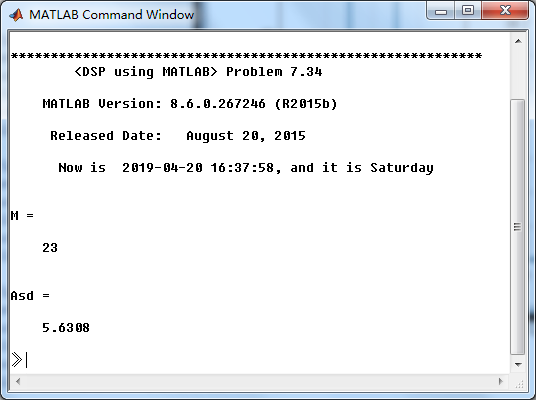
幅度谱如下

振幅谱如下:

第2个输入,及对应的输出
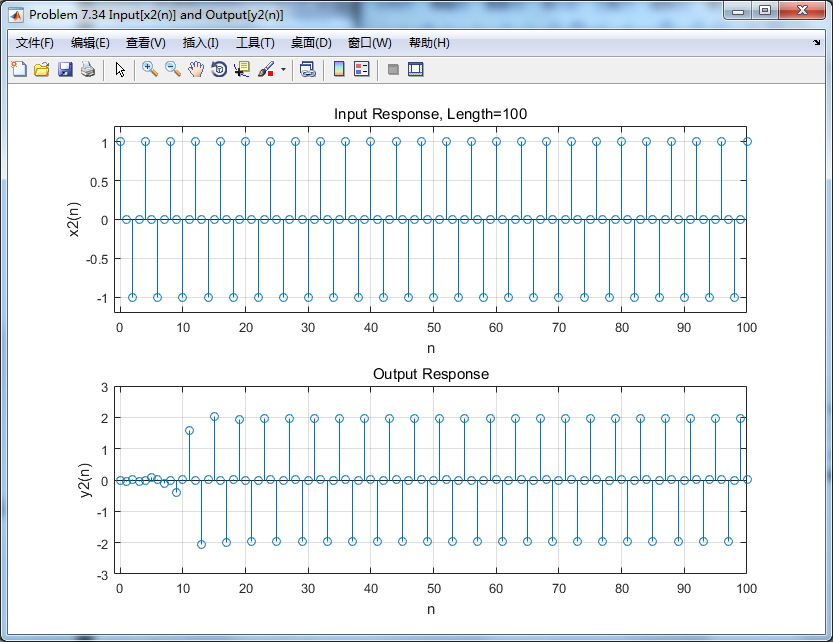
第2个输入输出的谱(DTFT)对比:
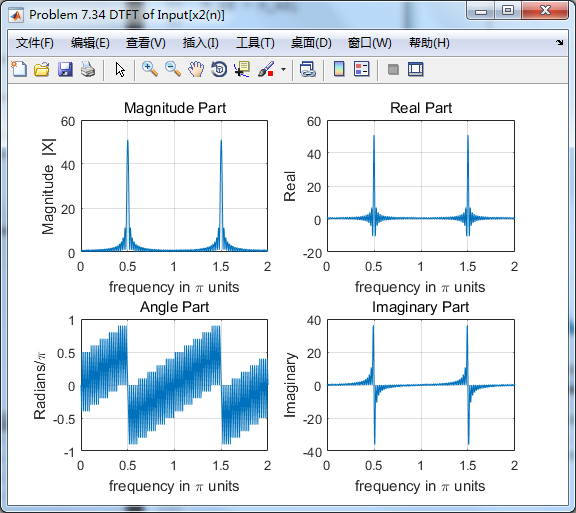
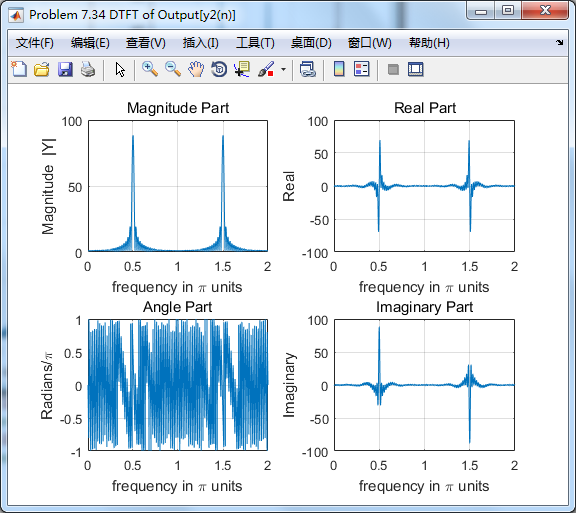

从图中看,输入0.5π分量幅度有所增大,几乎达到原来的2倍。
《DSP using MATLAB》Problem 7.34的更多相关文章
- 《DSP using MATLAB》Problem 5.34
第1小题 代码: %% ++++++++++++++++++++++++++++++++++++++++++++++++++++++++++++++++++++++++++++++++++++++++ ...
- 《DSP using MATLAB》Problem 8.34
今天下了小雨,空气中泛起潮湿的味道,阴冷的感觉袭来,心情受到小小影响. 代码: hp2lpfre子函数 function [wpLP, wsLP, alpha] = hp2lpfre(wphp, ws ...
- 《DSP using MATLAB》Problem 7.12
阻带衰减50dB,我们选Hamming窗 代码: %% ++++++++++++++++++++++++++++++++++++++++++++++++++++++++++++++++++++++++ ...
- 《DSP using MATLAB》Problem 7.35
代码: %% ++++++++++++++++++++++++++++++++++++++++++++++++++++++++++++++++++++++++++++++++ %% Output In ...
- 《DSP using MATLAB》Problem 7.27
代码: %% ++++++++++++++++++++++++++++++++++++++++++++++++++++++++++++++++++++++++++++++++ %% Output In ...
- 《DSP using MATLAB》Problem 7.26
注意:高通的线性相位FIR滤波器,不能是第2类,所以其长度必须为奇数.这里取M=31,过渡带里采样值抄书上的. 代码: %% +++++++++++++++++++++++++++++++++++++ ...
- 《DSP using MATLAB》Problem 7.25
代码: %% ++++++++++++++++++++++++++++++++++++++++++++++++++++++++++++++++++++++++++++++++ %% Output In ...
- 《DSP using MATLAB》Problem 7.24
又到清明时节,…… 注意:带阻滤波器不能用第2类线性相位滤波器实现,我们采用第1类,长度为基数,选M=61 代码: %% +++++++++++++++++++++++++++++++++++++++ ...
- 《DSP using MATLAB》Problem 7.23
%% ++++++++++++++++++++++++++++++++++++++++++++++++++++++++++++++++++++++++++++++++ %% Output Info a ...
随机推荐
- 2017/8/4 SCJP学习
2 Object Orientation . . . . . . . . . . . . . . . . . . . . . . . . . 85 Encapsulation (Exam Object ...
- Delphi THashedStringList用法
Delphi中的THashedStringList对象 Delphi在在IniFiles 单元中定义了THashedStringList类: THashedStringList = class(TSt ...
- Python机器学习的步骤
原文出处: kdnuggets 译文出处:数据工匠 开始.这是最容易令人丧失斗志的两个字.迈出第一步通常最艰难.当可以选择的方向太多时,就更让人两腿发软了. 从哪里开始? 本文旨在通过七个步骤,使 ...
- UVA-11987-Almost Union-Find-并查集的基本操作合并、删除、移位
I hope you know the beautiful Union-Find structure. In this problem, you’re to implement something s ...
- 微信小程序 tabBar模板
tabBar导航栏 小程序tabBar,我们可以通过app.json进行配置,可以放置于顶部或者底部,用于不同功能页面的切换,挺好的... 但,,,貌似不能让动态修改tabBar(需求:通过switc ...
- Django框架中session存储到redis中的配置
本文链接:https://blog.csdn.net/linqunbin/article/details/94786313————————————————版权声明:本文为CSDN博主「linqunbi ...
- 菲波那切数列(Fibonacci Number)
什么是菲波那切数列?自己google一下,面试题里面经常遇到,考试递归算法用的. 在菲波那切数列中用递归不太好.第三种算法最好. 第一 递归算法最差了,不想说.测试一下,当N=6000时,半天出不来数 ...
- java 上传MultipartFile和String post请求
/** * POST Multipart Request * @Description: * @param requestUrl 请求url * @param requestText 请求参数 * @ ...
- HDU3480 Division——四边形不等式或斜率优化
题目大意 将N个数分成M部分,使每部分的最大值与最小值平方差的和最小. 思路 首先肯定要将数列排序,每部分一定是取连续的一段,于是就有了方程 $\Large f(i,j)=min(f(i-1,k-1) ...
- AM历史消息及文件记录删除
1.下载 folderclear.bat 文件 2.用编辑方式打开这个文件 3.对里面的参数做修改 4.这个批处理文件,保留了 完整的一个月的消息记录 (如 今天是 2017.3.15 ,那么 清除数 ...
